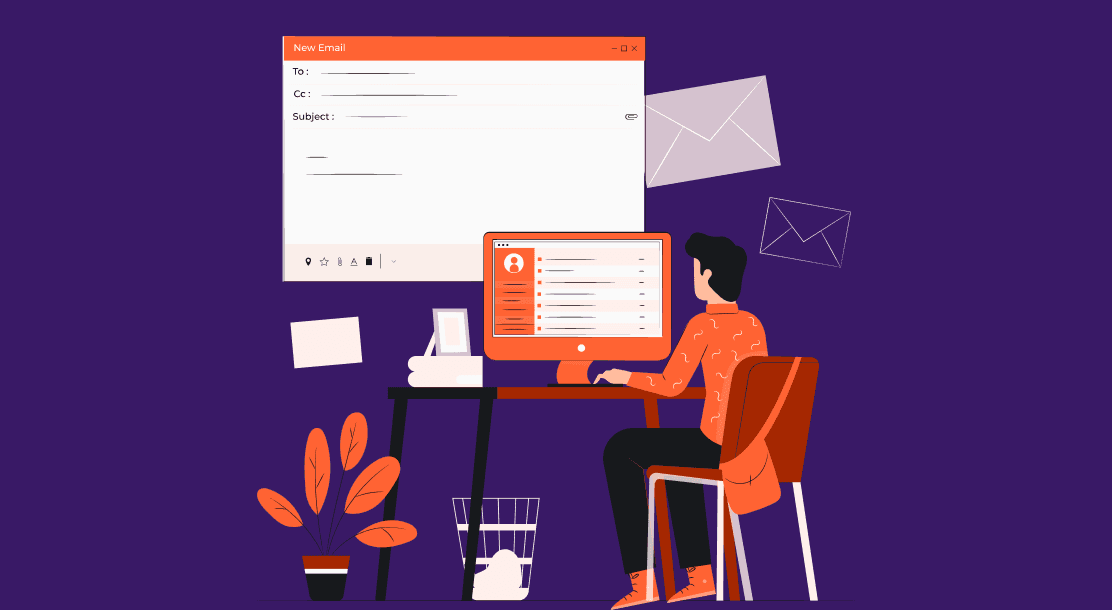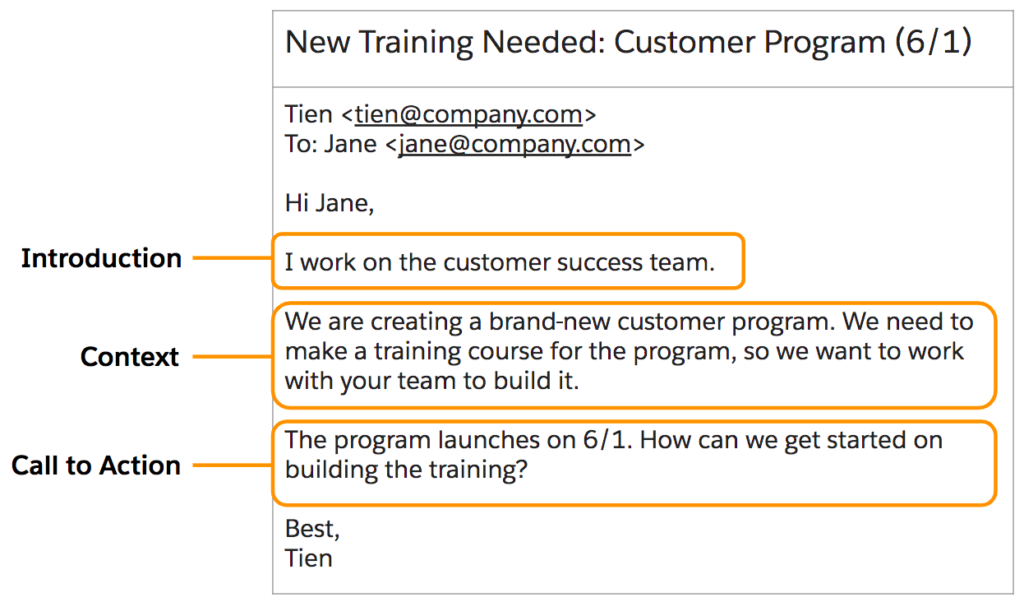
Table of Contents
- What Is Email Writing?
- Why Is Email Writing Important?
- 8 Tips for Writing Impactful Emails
- Key Takeaways
- Conclusion
- FAQs
Writing an email may appear simple. But when you get down to it, the task seems more daunting than ever. Despite spending a considerable amount of time writing the perfect subject line and body, and ending it with a call-to-action (CTA), nothing worthwhile seems to happen, because people aren’t even opening your emails. What is it that’s going wrong? It beats you. You must be desperately looking for some effective email writing tips in such a scenario. This blog gives you the best email writing tips worth following.
What Is Email Writing?
Email writing involves writing any form of content that may be part of a marketing strategy. It begins with a subject line, a preview text, and the main body. The writer of an email may do it for a brand, and the endeavor is to make it engaging enough for existing and new customers, for it to lead to conversions.
Fun fact: did you know that email was around even before the internet was made accessible to the public? Emails were first used to communicate between computers and were sent via computer servers.
Why Is Email Writing Important?
Today, email is part of almost all modern businesses, and no organization can do without this crucial means of communication. For most businesses, email is the primary way to communicate with customers and business partners. You can avoid unnecessary misunderstandings if the email is written correctly. Furthermore, emails are the fastest means to communicate and help you save time.

It is essential to follow email writing tips to ensure your emails are opened and viewed, and not deleted the moment they are received. A well-written email enhances your credibility and helps you build and nurture relationships. Emails allow you to spread critical information effectively and efficiently at a minimal cost. Without following email writing tips, you risk miscommunication, presenting a false impression of your company to a prospective customer, and even sounding offensive, if you don’t choose your words carefully.
8 Tips for Writing Impactful Emails
If you want your emails to perform well, it is imperative that you keep the email writing best practices in mind. To help you get started, we have put together key email writing tips.
1. Write an engaging subject line
Did you know that your subject line is like a headline, and it needs to be catchy and relevant? The best way to grab the recipient’s attention is to get your subject line right. If the subject line itself does not appear inspiring enough for the reader to open the email and take action, they will just ignore or delete it. Hence, it pays to spend valuable time to create a subject line, and conduct some research if you must, just as you would while writing a blog headline. You must spend at least one-third of your time preparing a subject line. Here are three important factors to keep in mind while creating your subject line.
Length
Research indicates that short subject lines (six to ten lines) have an excellent open rate. This is probably because people are hard-pressed for time, and most of them read their emails on hand-held devices, which makes reading a daunting task. Mobile users don’t have the patience to scroll through lines of content before taking action.
Words
Your choice of words, especially action verbs, is noticed by most recipients. They will know what to expect in the body of this email from the subject line. Using phrases like “Don’t miss this opportunity”, “act now” or “This is what you deserve” kindle a sense of urgency, provoking instant action.
Tone
Sounding welcoming and adding a personal touch by using the recipient’s name in the “To” fields guarantee great open rates. The email itself is like an instant message and has a personal touch to it, and you can enhance it by using a friendly tone.

2. Open your email with a relevant greeting
Begin the email with a suitable greeting to attract the recipient’s attention. Pay attention to the salutation and the crucial opening sentence. The salutation has to be decided depending on the scenario. If it is a formal email you are crafting to a financial institution or a government department, you must start with “Dear”.
However, if the email is for someone you already know or someone who works in the same organization as you, you can start with a “Hi” or “Hello”, followed by their first name. If you are addressing a group, and are not sure who the recipient may be, you can either start with “Hi/hello all” or “Hi team”, if you know the people you’re addressing. Whatever you do, you must not use genders or a casual “Hi guys/folks” greeting.
3. Use attention-grabbing opening sentences
While your subject line does one-third of the work, your attention-grabbing opening sentence can do one-fifth of the work. If your opening is good, you can rest assured that the recipient will read the email until the end.
Introductions should always be interesting and relevant to your target audience. All you need to do to find out what interests your recipients is to perform consumer analytics. Consumer analytics tools can give you valuable insights, and probably make one of the best email writing tips because knowing your target audience like the back of your hand makes all the difference.
4. Ensure your messages are concise
People tend to get bored by reading long messages and may give up as soon as they start. Did you know that a whopping 319 billion emails are sent and received every day, globally? Although people spend a lot of time reading emails, they can quickly become annoyed by lengthy, uninteresting emails. Most people scan their emails and only get down to reading them if they find something interesting. If you want your emails to stand out, follow these simple email writing tips.
- Write short paragraphs.
- Include bullet points.
- Keep your sentences short.
You may not have to convey everything in the first email itself. Just highlight the key takeaway, and never forget to include a CTA.
5. Don’t mix your fonts
Be consistent with the fonts you use. If you like Arial, stick to it throughout the email, and for all emails you send. It is easy to make it a habit to use the same font consistently. If you must focus on anything, try highlighting or italicizing only that portion, but that’s about it.
Don’t add colorful bits in between. Sticking to one font is almost a universal rule, so why not follow it? Arial, Calibri, Times New Roman, Verdana, and Helvetica are the most commonly used fonts. There are several more, and you may want to look up the entire list on Google, before settling for what appeals best to you.
6. Pay equal attention to the closing
The closing of an email is as important as its opening. After you have said what you wanted to say, it is time for a simple closing. A straightforward closing is appreciated by most readers, and no one wants any flamboyance there. There shouldn’t be any appeals or pleas towards the end or any profuse thanks. You can easily close the email with one or two words. Some common closing words include “Best regards”, “Warm regards”, “Thank you”, “Kind regards”, and “Best”.
7. Schedule your emails
Some effective email writing tips go beyond writing; they also emphasize the need to schedule emails. Checking emails is almost an addiction; professors at Stanford University call it a “pernicious addiction”. For most of us, it is a compulsive act, and the most popular time to read emails is early in the morning. The open rates start as early as 6:00 am, and gradually peak until 9:00 am. Hence, it is crucial to schedule your emails according to the demographics of your recipients.
It is a simple logic: the early bird gets the worm. So catch them early, and they are sure to read your email. You may take some time to arrive at a working schedule, but once you have it, stick to it.

8. End it with a strong CTA
The primary purpose of your email is to get your recipient to take action, for which a CTA is essential. Keep it prominent to be noticed, and promise a reward in return (ebook, bonus points, coupons, discounts, and the like). Remember not to confuse them with too many buttons or links, because they may end up clicking on nothing. Include one CTA that clearly tells your recipient what to do.
Key Takeaways
- Email writing is one of the most prominent forms of communication.
- The trick lies in knowing your buyer persona and identifying your target audience, which is probably one of the best email writing tips you can get.
- Once you know your target audience and their pain points, it is easy to offer solutions.
- Emails are like personal notes, and they must reflect a personal touch.
Conclusion
Email writing lets you reach out to relevant people, and there’s hardly any time wasted in the exercise. Moreover, it is one of the cheapest methods of communicating with numerous people and probably has the highest conversion rates. If you follow the best email writing tips to a T, you’ll be sure to create a winning email marketing campaign.

FAQs
One of the best email writing tips experts give is focusing on the subject line. The next important thing is using bullet points to make your email easily scannable. Don’t forget to add a CTA at the end of the email, as it makes your readers take action immediately. Keeping your email short and concise makes effective email writing, as also being collegial and maintaining a friendly tone. Avoid offensive or rude words.
Some effective email writing techniques include the following points.
– Be precise and keep your emails short and simple.
– Never use “no-reply” email addresses, as they may be deleted without being opened.
– Using all-caps should be avoided, as it suggests you are yelling at the reader.
– Never make false promises that you will never be able to keep.
– Effective email writing involves using numbers and values liberally, as they stand apart and grab the readers’ attention.
– Try to sound friendly, and at the same time, make the recipient feel important.
Common email writing tips suggest two ways to start an email: either with “Hi”, or “Dear”. Starting with “Greetings” sounds friendlier. If you want to remain formal yet courteous, just writing “Hello”, followed by the recipient’s name, should suffice.
If you are addressing multiple recipients or a group, it is best to start with “Hi all”, or “Hi everyone”. It is crucial to avoid grammatical mistakes in all your emails. If you are not sure, it is better to use a tool like Grammarly to check for discrepancies in your email before sending it.
As with any email, a professional email needs to start with an appropriate subject line. Professional email writing techniques include addressing the recipients correctly. Avoid lengthy sentences and beating about the bush: be straightforward and to the point.
Professional emails must be easy to read, and slang should never be used. Display your charisma and sound thankful. If you have written to the same recipient earlier, you may want to remind them of the previous conversation, especially if it’s a follow-up.
Popular email writing tips include sounding formal and good-mannered. Most importantly, you must optimize your subject line and be clear about what you are addressing, lest the reader gets confused. Ensure your email has a suitable opening, body text, and closing; and use appropriate salutations in all your communication.
Latest Blogs
Explore how Google’s 2025 AI search updates triggered ranking chaos. Learn actionable strategies to adapt your SEO for AI Overviews, zero-click searches, and SERP volatility. Stay ahead now.
Learn how to rank on AI search engines like ChatGPT, Perplexity, and Gemini by optimizing your content for authority, structure, and relevance. Stay ahead in AI-driven search with this strategic guide.
Explore the best healthcare SEO services for your medical practice. Improve online visibility and effectively reach more patients in need of your services.
Get your hands on the latest news!
Similar Posts

Email Marketing
6 mins read
11 Tips to Design Impactful Email Banners

Design
9 mins read
7 Benefits of a Simple Mailer Design

Email Marketing
7 mins read